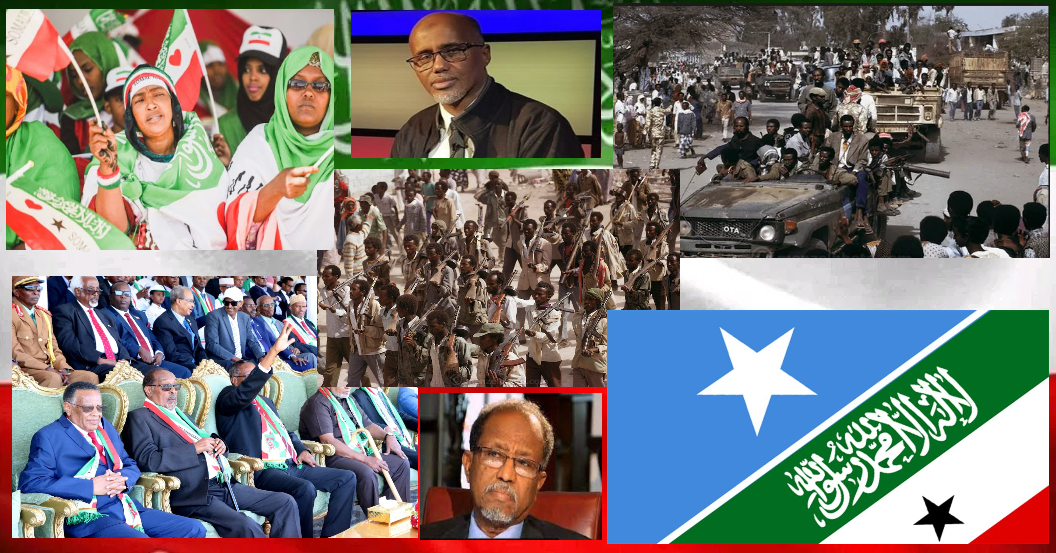
May 18 is widely celebrated in Hargeisa, Burao and Berbera as the day the self-proclaimed “Republic of Somaliland” declared its “independence” from the rest of Somalia. However, the revelers have little or no real knowledge of the real facts leading up to this day.
For the few vocal believers in separatism, as well as non-believers, and for everyone else not familiar with the history of the northern regions, it is noteworthy to remember some true facts that were pushed under the carpet for so long.
The power vacuum that sealed the North’s fate
On 26th of January 1991, late president Mohamed Siyad Barre fled the country when the United Somali Congress (USC) clan militia took over Mogadishu. By then, the Somali National Movement (SNM) militia fighting in the northern regions were beaten and hunted down.
Nevertheless, within a week, the newly appointed prime minister, Omar Arteh Qalib, took the puzzling step to request Somali Army units fighting anti-government militias to cease fire and surrender to those militias.
Somali army officers stationed in the North were well aware of the hate propaganda carried out by the SNM against them and reports of massacres perpetrated by their militiamen against civilians.
For this reason, soldiers, from the southern regions, felt betrayed by their government and out of fear for their safety simply put down their uniforms and weapons and vanished.
Followed days of unprecedented terror that culminated by Dila and Borama massacres, on February 4th. Then, the SNM started the process of de-escalating the tension in the Northern regions and called northern clans for a meeting in Berbera, on February 15, 1991, to “build confidence”.
SNM attempts to cover the blood trail
However, looting, skirmishes and displacements were still common all over the region. And it is in this context of hostility, human sufferings and destruction that between April and June 1991 the Burao Conference was held in a warehouse in the town of Burao.
The conference, dubbed the “Northern Peace Conference”, had an impact on the history of the Somali people in general and the Northern regions in particular as it sealed their destiny for the next three decades, for better and for worse.
On that day, the top leadership of the SNM deceitfully invited traditional elders, politicians, military and religious leaders from clans fighting in these northern regions but the SNM had a hidden agenda, as it was already decided in Hargeisa by SNM Central Committee what the outcome of the meeting should be.
All the delegations, not affiliated to the SNM clan, were taken aback after much talk about peaceful coexistence, shared history and common destiny that they had to sign, at gunpoint some said, a “joint” statement which included the North secession from the rest of Somalia.
Secessionists deceit
The fairy tale used as a history by secessionist elements in the SNM described the statement as a consensual agreement.
Testimonies abound from parties present at the conference, including Ali Khalif Galayr and other dignitaries, confirmed the conference was a political kidnapping designed to lure them out of their stronghold in Sool and Sanaag. They said they were coerced to sign a decision for which they were not prepared.
Moreover, according to the late Mohamed Bashe, ex-SNM intellectual and leader of Markale Midnimo (United Again), a recently formed Somali unionist organization, separatism was never part of the SNM agenda and article 6 of the SNM constitution clearly highlighted that.
Mr. Bashe said also the SNM agenda for Somalia was hijacked by two secessionist individuals within the Central Committee who found a listening when Ali Mahdi self-proclaimed President of Somalia.
18 May dying days
More revelations or research would nevertheless enlighten this discussion whether the separatism idea was purely the brainchild of the two individuals implicated or it was planned and directed by foreign governments.
Thirty years have passed since the conference and festivities are held every year in Hargeisa and wherever communities impregnated with separatism reside.
Unfortunately, the promise of an independent and internationally recognized “Republic of Somaliland” never materialized but only brought more isolation and dependence on foreign aids.
Although in recent years there has been a lack of meaningful celebrations due to the month of Ramadan and the COVID-19 pandemic, fatigue, hopelessness and depression are evident in the Somaliland community members who were led to believe their own myths about clan exceptionalism.
Time for the masks to fall
Markale Midnimo’s public statement and campaign for One Somalia is a courageous first step in the right direction by intellectuals hailing from the North and translate the current unease in Somaliland’s desperate situation.
Young people have been lied to for the past 30 years. June 26 is the only Independence Day, there was no SNM military prowess, no consensus on secession, and no foreseeable recognition of an independent state.
Moreover, the one-clan-takes-all politics that has characterized Somaliland so far has divided the northern regions more than ever.
Worse, as Hargeisa’s elite spend millions promoting the bogus ‘Independence Day’ and myths around 18 May are entrenched in school textbooks, it’s just another” Nakba Day” for disenfranchised people from Awdal, Togdheer, Sool and Sanaag regions.
Make no mistake, the intention of this article is not to argue for a united Somalia but rather to show that the status quo is intolerable. The northern, central and southern Somali regions share similar misery these days. They are all vulnerable and dependent on foreign aid and interference.
The Horn of Africa region is in the midst of transformation and Somali communities in all regions are fed up with clan loneliness and being led to believe that their worst enemies are fellow Somalis.
To sum up, the real solution to saving the Somali nation lies in young people thinking outside the box, not old school divisive politicians.
